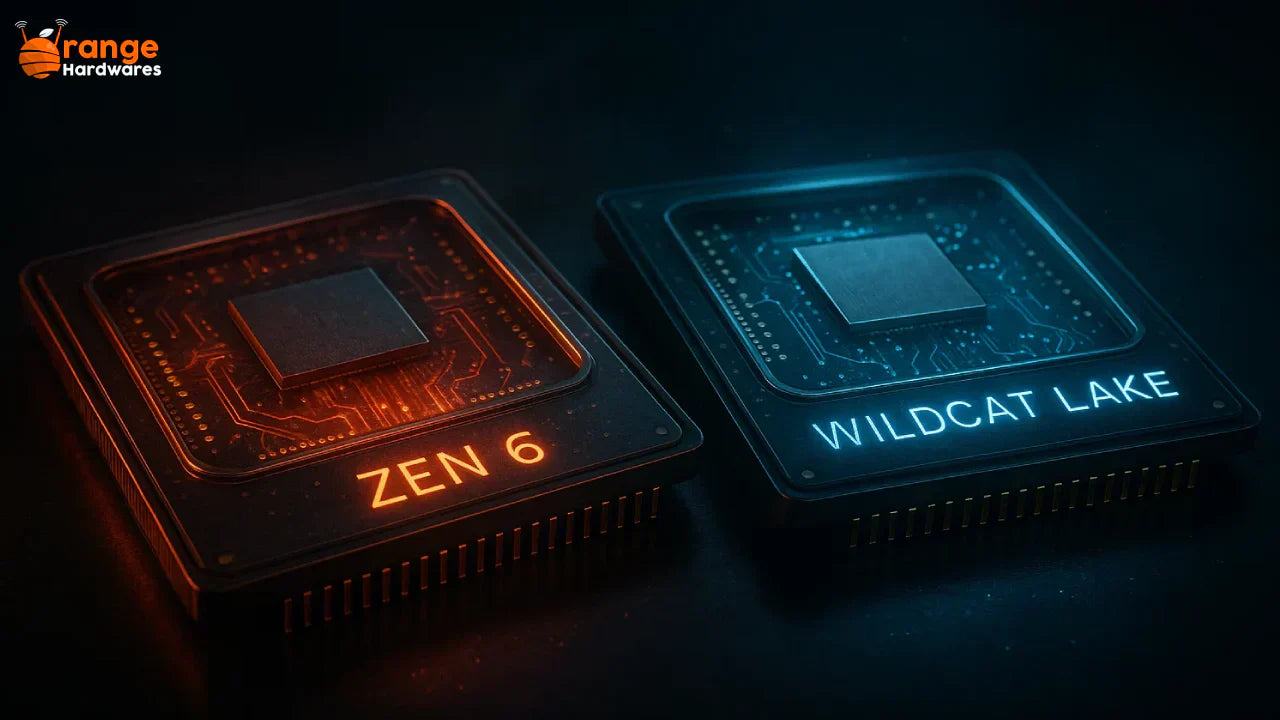A recent update to the famous diagnostic software AIDA64 has sparked excitement among demanding tech users by listing two unreleased processor families, known as the AMD Zen 6 and Intel Wildcat Lake.
The 7.70.500 build discovery, silently adds preliminary support for both CPU architectures, suggesting that firmware testing and internal validation are already in the process. Although neither Intel nor AMD has given any comments on this officially, there has been insight into their next-gen processor plans.
It hints at upcoming enhancements in performance, efficiency, and AI-driven processing, which are expected to represent the next hardware cycle. Until further details, the AIDA64 update stands as the best clue yet that both CPU brands are preparing major releases for 2026 and beyond, making it an exciting time for users planning to buy processors.
What is the release date of AMD Zen 6?
When is AMD Zen 6 coming out? It is a question that many AMD processor fans are asking. According to leaked information, the AMD Ryzen Zen 6 release date is said to be in the fourth quarter of 2026, at least 18 months after the Zen 5 model. Many sources claim engineering samples of AMD processors are already in testing, with production likely beginning in the middle of 2026. Desktop variants will be leading, with mobile and embedded variants coming next.
Mobile variants, like Medusa Point, could arrive later in early 2027, continuing AMD’s pattern of staggered launches across desktop, mobile, plus server markets. If accurate, Zen 6 could be officially unveiled at CES 2026 or Computex 2026, signifying AMD’s next major generational leap.
AMD Zen 6 Shows a New Leap in Design
AMD CPU Zen 6 is shaping up as one of AMD’s largest architectural overhauls yet. The CPU is built on TSMC’s 3nm node, with the possibility of moving to 2nm for select SKUs. Zen 6 CPU promises better single-core gains, enhanced power scaling, and increased multi-threaded output
Earlier launched reports reports hint at an increase from 8 to 12 cores per CCD, marking AMD’s first significant chiplet reconfiguration since its Zen 2 generation. Combined with enhanced cache hierarchy and clock headroom, Zen 6 could lead to both workstation tasks and gaming.
Expected Key Improvements
- 12-core CCD built for stronger parallelism
- Bigger 3D-VCache for top-end gaming models
- Adaptive voltage scaling for power savings
-
Full compatibility with upcoming AM5 platforms
AMD will likely extend Zen 6 across Ryzen, Threadripper, plus EPYC Venice platforms, continuing its single-chiplet strategy.
Recommended: AMD Ryzen Threadripper 9970X & 9980X Review
Looking at the Architecture Highlights of the AMD Zen 6 Architecture
The AMD Zen 6 architecture will evolve AMD’s modular design with heavier chiplets and tighter CPU to GPU, input, and output interconnects. It is expected to introduce a rebalanced cache setup and upgraded Infinity Fabric for higher bandwidth communication.
Rumored Technicalities:
- Refined chiplet layout with advanced interconnects
- Up to 256 cores in EPYC Venice configurations
- 3D-stacked cache options for all gaming models
-
Support for DDR5 memory and PCIe 6.0 interface
If this information is accurate, Zen 6 could provide record-breaking performance per watt while maintaining scalability or compatibility from laptops to hyperscale servers.
Recommended: Best Processors for Servers
The Mobile Resolution of Zen 6 Medusa
In AIDA64’s software releases, one of the most exciting launches to look forward to is the AMD Zen 6 Medusa, which is believed to be AMD’s next-generation APU platform. It is expected to combine Zen 6 CPU chiplets with RDNA graphics and a dedicated AI engine, providing desktop-level performance in portable builds.
The Medusa Point could succeed AMD’s Phoenix and Hawk Point APUs, bringing multi-chip scalability to laptops for the first time, ever. Early engineering leaks indicate a strong aim on energy optimization, as well as integrated NPU acceleration.
Expected benefits of the Zen 6 Medusa include:
- Enhanced performance-to-battery ratio
- RDNA integrated GPU for next-gen gaming laptops
-
Multi-chip design enabling increased efficiency
If AMD’s roadmap is genuine, Zen 6 Medusa laptops may debut in early 2027, shortly after the release of the AMD Gen 6 desktop.
AMD Zen 6 Leaks and Validation Signs
The AMD Zen 6 leaks from AIDA64, Linux drivers, plus OEM roadmaps show that AMD’s next-gen silicon is already being tested internally.
AIDA64 typically adds processor IDs only after receiving validated microcode from AMD, which confirms that early validation is already in the process. More leaks point to prototype boards circulating among partners, which indicate stable hardware builds.
Wildcat Lake Intel is Intel’s Silent Evolution
The very same AIDA64 update references Wildcat Lake Intel processors, an upcoming low-power CPU family believed to succeed the Alder Lake-N. The CPU is designed for compact systems and ultrabooks, and emphasizes power efficiency and integrated AI acceleration, instead of raw performance.
Early identifiers point toward next-gen E-cores and hybrid design options for selected models. Wildcat Lake fits Intel’s strategy of refining its lower-power lineup, which has expanded increasingly, and is competitive with AMD’s U-series, plus Apple Silicon devices.
Intel Wildcat Lake Expected Release Date
Recent reports have indicated the Intel Wildcat Lake release date to be in the first quarter of 2026, shortly after Panther Lake, and before Nova Lake architecture. Several OEM planning maps already talk about Wildcat Lake-U modules, which are intended for embedded systems and Industrial PCs.
Linux Kernel patches that reference Wildcat Lake confirm that driver-scale integration is going on, which is a common sign of chips entering the pre-production phase. These chips are built on Intel’s 18A process, and will consist of enhanced Xe graphics cores, plus AI-backed architecture for lighter compute taskloads.
Recommended: Intel Arrow Lake Performance Problems and Fixes
What to Look for in the Intel Wildcat Lake
Though complete specs still remain to be announced, insider reports predict that Intel Wildcat Lake will focus on power efficiency, responsiveness, as well as improved integrated performance.
Expected Features of the Intel Wildcat Lake:
- Up to 8 E-cores with possible hybrid configurations
- Next-gen Xe GPU for multimedia workloads
- Edge computing through integrated AI accelerators
- LPDDR5X memory support for increased bandwidth
-
Power envelope between 9 W – 25 W for fanless designs
These features could make Wildcat Lake a top choice for ultra-level portables, industrial IoT systems, plus energy-conscious PCs by the year 2026
Zen6 and Wildcat Lake Rumored Specs Summary Table
|
Specification |
AMD Zen 6 (Rumored) |
Intel Wildcat Lake (Rumored) |
|
Architecture |
Zen 6 (3 nm / 2 nm TSMC) |
18A Node Architecture |
|
Launch Window |
Late 2026 |
Early 2026 |
|
Core Configuration |
Up to 12 cores per CCD |
Up to 8 E-cores (hybrid optional) |
|
Process Node |
TSMC N3 / N2 |
Intel 18A |
|
Cache Design |
Expanded 3D-VCache |
Standard L2/L3 with AI boost |
|
Power Efficiency |
Adaptive Voltage Scaling |
Low-TDP (9–25 W range) |
|
Integrated GPU |
RDNA-based (APU models) |
Xe-LPG+ Graphics |
|
AI Acceleration |
Dedicated NPU (Medusa variant) |
On-die AI Engine |
|
Target Devices |
Desktops, Laptops, Servers |
Ultrabooks, Mini-PCs, IoT Systems |
The Importance of the AIDA64 Upgrade
AIDA64’s inclusion of Zen 6 and Wildcat Lake architectures isn’t just a coincidence; it is an important sign that both have reached internal validation.
As known by past reports, AIDA64 support starts 12 to 18 months before launch. This timeline helps OEMs start firmware and BIOS optimization early, guaranteeing a ready new model launch for later hardware ecosystems.
Conclusion
The AMD Zen6 and Intel Wildcat Lake models note significant steps towards the upcoming evolution of computing, with Zen6 going for top-performance scalability across desktops and servers, while Wildcat seeks excellent design and energy efficiency. With AIDA64 now recognizing both these AMD and Intel architectures, anticipation builds for a release somewhere in the middle of 2026 and the beginning of 2027, in hardware.
Users are awaiting details of what Zen6 and Wildcat have in store in computing, in terms of speed, efficiency, and cutting-edge technology.

Dedicated Specialists
(855) 703-4322We accept POs from Fortune 1000, government agencies, defense, schools, hospitals, veteran, and women-owned companies.





